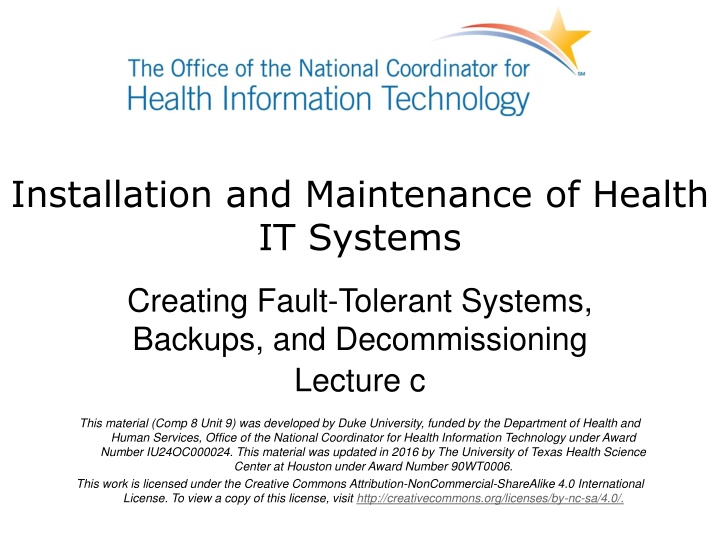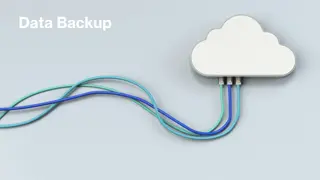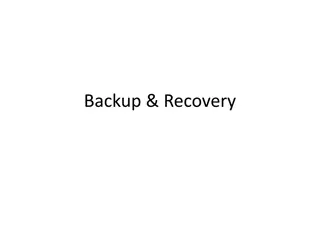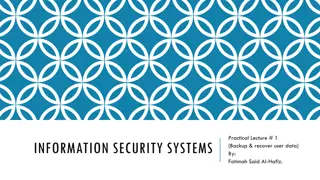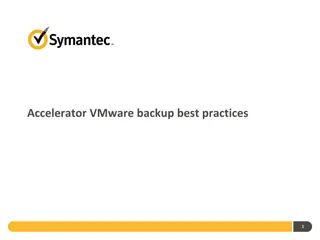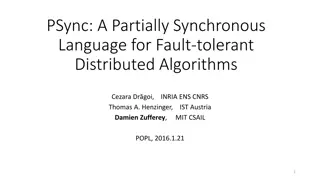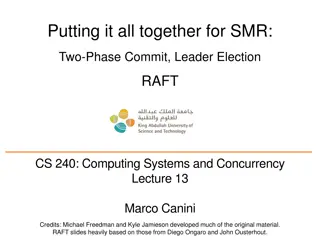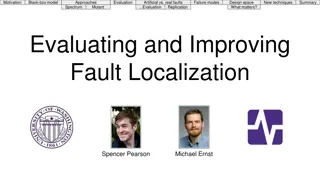Health IT Systems Maintenance: Fault-Tolerant Strategies and Backup Best Practices
Explore the essential practices for creating fault-tolerant IT systems in healthcare, including risk assessment, backup strategies, and decommissioning guidelines. Learn about the importance of backups, backup strategies, and the challenges of maintaining system availability 24/7.
Download Presentation

Please find below an Image/Link to download the presentation.
The content on the website is provided AS IS for your information and personal use only. It may not be sold, licensed, or shared on other websites without obtaining consent from the author.If you encounter any issues during the download, it is possible that the publisher has removed the file from their server.
You are allowed to download the files provided on this website for personal or commercial use, subject to the condition that they are used lawfully. All files are the property of their respective owners.
The content on the website is provided AS IS for your information and personal use only. It may not be sold, licensed, or shared on other websites without obtaining consent from the author.
E N D
Presentation Transcript
Installation and Maintenance of Health IT Systems Creating Fault-Tolerant Systems, Backups, and Decommissioning Lecture c This material (Comp 8 Unit 9) was developed by Duke University, funded by the Department of Health and Human Services, Office of the National Coordinator for Health Information Technology under Award Number IU24OC000024. This material was updated in 2016 by The University of Texas Health Science Center at Houston under Award Number 90WT0006. This work is licensed under the Creative Commons Attribution-NonCommercial-ShareAlike 4.0 International License. To view a copy of this license, visit http://creativecommons.org/licenses/by-nc-sa/4.0/.
Creating Fault-Tolerant Systems, Backups, and Decommissioning Learning Objectives 1. Define availability, reliability, redundancy, and fault tolerance (Lecture a) 2. Explain areas and outline rules for implementing fault tolerant systems (Lecture a) 3. Perform risk assessment (Lecture a) 4. Follow best practice guidelines for common implementations (Lecture b) 5. Develop strategies for backup and restore of operating systems, applications, configuration settings, and databases (Lecture c) 6. Decommission systems and data (Lecture c) 2
Importance of Backup Volume of data: hospital can generate 12 terabytes/yr in radiology alone. HIPAA (Health Information Portability & Accountability Act) Security Rule requires exact backup copies of all healthcare data, easily retrievable Should be called Importance of Restore (Surviving a Bottleneck, 2009) 3
Backup Strategies: Requirements Laws regarding length of time health information data must be retained depend on the jurisdiction (usually state), and can involve: Flat length of time (X years) Age of patient Time since age of majority, or of discharge, or of death Length of statute of limitations for malpractice What constitutes best practices for a backup? Exact, verified copy of the material Multiple copies! Stored off-site location in case of natural disaster, fires, flooding, etc. Easily retrievable for timely restoration Security via encryption and storage in secure location Fault tolerant storage protection (like RAID) is not enough Deleted files Old versions (AHIMA Practice Brief, n.d.) 4
Backup Strategies: Backup Window Time required to complete a given backup. Determined by amount of data to be backed up divided by speed of network infrastructure Backups that occur during production hours may be inconsistent (bad) Problems when backup window reaches peak operation cycles, potentially straining resources and slowing down the system What to do when system must be available 24/7? (Harwood, 2003) 5
Backup Strategies: Which Files? Full backups All files Pro: Ultimate protection, simple restoration Con: Requires more time & lots of storage to keep multiple file versions Incremental backups Only files that have changed since last backup (full or incremental) Pro: Much faster Con: Restoration from multiple files (Harwood, 2003) 6
Backup Strategies: Which Files? (cont d) Differential backup Middle ground: all the files that have changed since the last full backup Pro: easier restoration Synthetic full backup Compensates for small/nonexistent backup window Data from last full backup + differential / incremental backup combined to create new full backup tape (Harwood, 2003) 7
Backup Strategies: Which Files? (cont d - 1) File system snapshots Available through VM environments and later UNIX versions Backups at several times through the day without needing large amounts of additional storage media Reliable backups without shutting down applications (Harwood, 2003) 8
Backup Strategies: Where to store data Direct backup Tape drive / autoloader / library directly connected to every server to directly backup and restore data Does not scale well Centralized network backup One server backs up data of all servers SAN (Storage Area Network) backup Storage network to which all servers & backup device connect (Gordon, n.d.) 9
Backup Strategies: Backup Media Storage of media should cycle off-site Tapes Robust but expensive Optical Inexpensive, relatively small, convenient Flash Robust, convenient, fast Hard disk Cheap, fast but fragile, bulky Network or Cloud backup Dependent on network throughout 10
Backup Strategies: Databases Databases require extra considerations, depending on the database infrastructure used Consult with database or EHR vendor to ensure backup strategy is compatible with database infrastructure. Database backup is usually through specialize tools or applications, often provided with the database. 11
Decommissioning Goals in retiring old systems / applications / datasets Active data properly retained Inactive data archived or disposed of securely Tips Complete full data audit; note redundancies. Determine data owners and stakeholders. Identify active vs. inactive data. Consider reporting / retrieval requirements for compliance. 12
Decommissioning (contd) Tips (cont d) Document retention policies well & ensure consistency with government guidelines. Standardize on single, well-navigable archival system. Develop decommissioning plan & schedule. Ensure integrity of archived data and destruction of decommissioned data. 13
Creating Fault-Tolerant Systems, Backups, and Decommissioning Summary Lecture c Regulatory requirements for backups are stringent An effective backup strategy minimizes the backup window while ensuring data integrity. Backup considerations: Onsite vs Off-site Full vs Partial Media Verification Decommissioning Active data properly retained Inactive data archived or disposed of securely 14
Creating Fault-Tolerant Systems, Backups, and Decommissioning Summary Regulatory requirements for backups are stringent An effective backup strategy minimizes the backup window while ensuring data integrity. Backup considerations: Onsite vs Off-site Full vs Partial Media Verification Decommissioning Active data properly retained Inactive data archived or disposed of securely 15
Creating Fault-Tolerant Systems, Backups, and Decommissioning References Lecture c References Surviving a Bottleneck - Insights into Managing Exponential Growth of Digitized Medical Images. (2009, March 16). Retrieved from Scicasts website: asts.com/specialreports/86-healthcare-it/2442- surviving-a-bottleneck-insights-into-managing-exponential-growth-of-digitized-medical-images Gordon, S. (n.d.). Comparing different backup strategies. Retrieved February 8, 2007, from SearchStorage website: http://searchstorage.techtarget.com/tip/Comparing-different-backup- strategies Retention and Destruction of Health Information. State Laws or Regulations Pertaining to Retention of Health Information. (updated 2013). Retrieved June 24, 2016, from AHIMA website: http://library.ahima.org/PB/RetentionDestruction#.V3Li1fkrJD8 16
Installation and Maintenance of Health IT Systems Creating Fault-Tolerant Systems, Backups, and Decommissioning Lecture c This material was developed by Duke University, funded by the Department of Health and Human Services, Office of the National Coordinator for Health Information Technology under Award Number IU24OC000024. This material was updated in 2016 by The University of Texas Health Science Center at Houston under Award Number 90WT0006. 17
